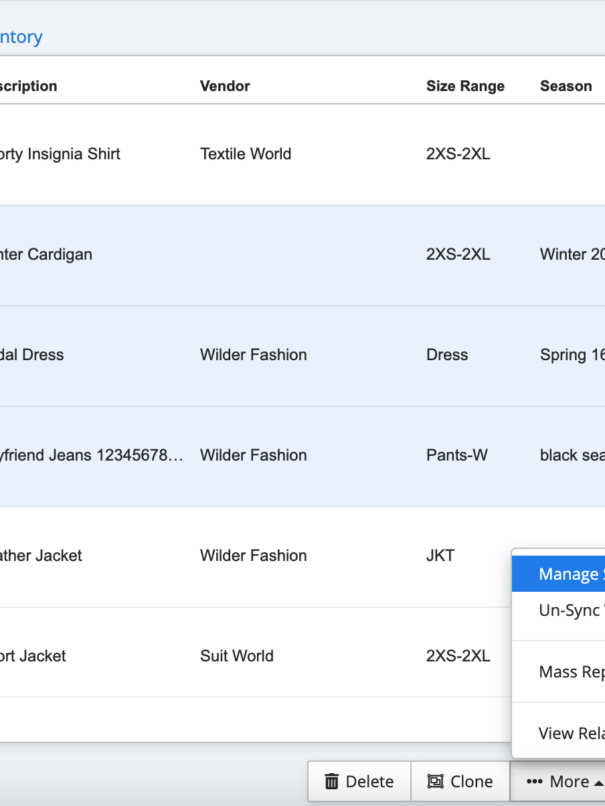
With mounting competition in the modern apparel business industry, success relies on taking advantage of every opportunity to increase profitability. So, what does the future of the apparel business look like in terms of growth opportunities in 2023? The answer may lie in ERP (Enterprise Resource Planning) automation functionalities.
Those functionalities include AI-enabled inventory control, order processing, access to real-time reports, and so much more. With the help of ERP automation, companies can reduce operational costs by streamlining manual processes and repetitive tasks and optimizing the supply chain, boosting productivity, and ensuring that operations are running the right way.
Additionally, this automation can increase customer satisfaction by providing them with accurate information on product availability and delivery dates.
Ultimately, harnessing the power of ERP automation functionalities may prove to be a critical factor in achieving success in the ever-changing apparel industry in 2023.
Let’s take a deep dive into how exactly ERP automation can help you run an apparel business worthy of accolades, and answer the question of how to implement an ERP system effectively.
What’s Happening in the Fashion Industry in 2023
The eCommerce business model has gained immense popularity. As things stand, Shopify is booming, with more than 500.000 stores active. All of this indicates that nothing is stopping the apparel industry from evolving throughout 2023.
Key trends include direct-to-consumer sales, personalization, and sustainability. Nowadays, customers want a comfortable shopping experience, rich and field with meaningful opportunities for connection with brands. And luckily, it’s not hard to deliver that as businesses can use both on-site methods, such as live chats to engage with their customers and help them enjoy a better experience, or via social media platforms.
However, while it’s pretty easy for businesses to engage with prospects, they face significant challenges navigating global supply chain disruptions and keeping up with fast fashion trends. Still, technological advancements in the fashion industry are hard to ignore. Artificial intelligence, the Internet of Things, and data analytics enable apparel companies to forecast trends, optimize production, and deliver personalized experiences without a hitch, and those that are not leveraging them, are lagging behind.
By leveraging software solutions such as ERP automation tools, apparel businesses can gain real-time data visibility into operations and make data-driven decisions to thrive in today’s dynamic landscape.
ERP, the Key to Unlocking the Potential of Apparel Businesses
The apparel industry is a vast industry that encompasses various divisions, including production planning, computer-aided design, retailing, accounting, manufacturing, quality control, and so much more. Each area plays a significant role in the success of the business, from designing and manufacturing garments to managing finances and human resources.
Effective supply chain management is also crucial to keep the warehouse and inventory in good shape. With the growing complexity of the industry, apparel businesses can benefit from the use of specialized ERP software to streamline processes across departments. Such software offers accurate and up-to-date stock and location information, leading to better decision-making and faster delivery of products.
Choosing the Right ERP System
When choosing an ERP automation solution for an apparel business, there are many factors to consider. Scalability and integrations with other software applications are some of the most important considerations when selecting an ERP automation solution.
Additionally, cost and user experience should also be taken into account. It is essential to identify the current needs and future goals of the business in order to determine what type of ERP automation system is best suited.
ERP automation software options are widely available online. Each software offers different features that can help businesses fulfill their specific needs. For example, some are specifically geared towards mid-size companies and provide functions like inventory management and product configurator, while some support enterprise-level implementations and provide capabilities such as distribution management and accounting.
Needless to say, the best ERP systems have high integrability enabling users to expand their functionalities with just a simple click of a button. Having the ability to develop the features of your ERP system as you grow your business operations is something each business needs in its arsenal of tools.
Don’t Forget the Integrations
When it comes to selecting the right ERP for a fashion apparel business, you want a system that comes equipped with product lifecycle management, customer relationship management, and other features.
Having an ERP with these extras can help automate the process of managing inventory, invoicing customers, tracking sales data, and more – all while keeping customer satisfaction at peak levels. This ensures that you can keep up with the needs of your customers better and grow your business faster.
Implementing an ERP System for Apparel Businesses
To ensure an effective ERP system implementation for apparel businesses, it is important to clearly define goals and objectives. Evaluate different solutions and select one that best fits the business needs, taking into account major features, scalability, compatibility with existing systems, and cost. Assemble a project team of professionals with expertise in the apparel industry, IT, and project management to manage the implementation process.
Prepare hardware and software infrastructure for the new system to ensure adequate support. Data must be clean and consistent before the transfer to the new system happens. Employees need training on the new system and thorough testing conducted before going live.
Once live, monitor performance regularly and continuously improve processes to maximize ERP benefits – ultimately leading to improved efficiency and bottom-line results.
A Handful of Benefits You Can Enjoy From Using ERP Automation Solutions

- Streamlined inventory management: With an ERP system in place, businesses can gain real-time visibility into inventory levels, orders, and shipments to optimize stock levels and reduce waste, as well as ensure customer demands are met.
- Improved production planning: An ERP system can help organizations schedule production more efficiently by taking into account lead times, capacity, and resource management/availability, leading to decreased bottlenecks and improved productivity.
- Faster order processing: Automating order processing through an ERP system helps reduce the time it takes to fulfill orders and do routine tasks from receipt to delivery, increasing customer satisfaction and assisting companies to remain competitive.
- Better financial control: An ERP system provides better insight into a company’s financial management, making it easier for them to monitor expenses, revenue, and cash flow while making more intelligent business decisions that increase profitability.
- Enhanced collaboration: Through an ERP system, different departments within a business can share information speedily while promoting a cohesive organizational culture with reduced errors.
- Increased scalability: As companies develop and grow, their needs change; an ERP system is highly customizable and configurable, which makes it a flexible tool for companies of all sizes.
Why You Need an ERP System
By seamlessly integrating various business processes, an ERP system eliminates redundant procedures, reduces data entry errors, and makes it possible for business owners to manage and control their entire operation effectively.
One of the significant advantages of implementing an ERP system is that it can help store massive amounts of data across a wide range of business processes, providing business owners with the flexibility they need for future growth and expansion.
Additionally, accurate inventory tracking is a critical feature of an ERP system that can prevent storage space issues, cash flow strain, and delivery delays. It allows companies to track inventory levels in real time, make informed purchasing decisions, and ensure the efficient flow of goods through their supply chain.
Furthermore, by having access to an ERP system, businesses can improve customer experience by providing progress updates, making on-the-fly adjustments, and ensuring the timely delivery of products or services.
Moreover, all the best ERPs are cloud-based systems, so you never have to worry about downloading or installing software on your devices.
Conclusion
ERP automation functionalities can be a critical factor in achieving success in the apparel industry in 2023 and in the future. With the help of AI-enabled inventory control, real-time data, order processing, invoicing, reporting, and more, companies can reduce operational costs, optimize the supply chain, and increase customer satisfaction.
The apparel industry will continue to evolve with direct-to-consumer sales, personalization, and sustainability trends, and technological advancements such as AI, IoT, and data analytics becoming more prominent. As an apparel business leader, that technology can enable you to forecast trends, optimize production, improve business functions, and deliver personalized experiences for customers. Due to this, it’s in your best interest to keep an eye on systems that help you carry out multiple processes from one single hub.
By following best practices for implementation, businesses can benefit from increased productivity, profitability, and compliance while promoting a cohesive organizational culture with enhanced collaboration.







